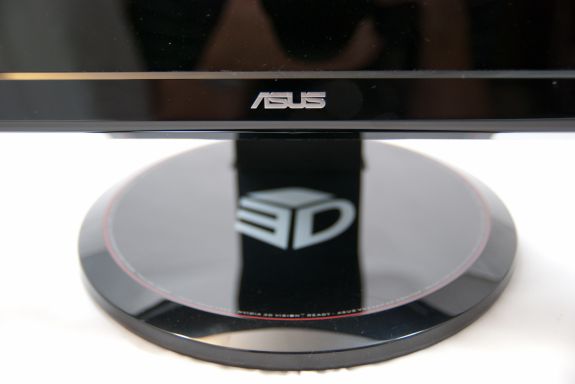ASUS VG236H 23-inch 3D Display Review: 120Hz is the Future
by Brian Klug on August 7, 2010 2:48 AM ESTIntroduction
120Hz panels are definitely still market newcomers - in fact, look no further than Newegg, where there still isn’t a 120Hz category, much less a refresh rate field for drilling down products. The necessity for 120Hz panels arose entirely out of the ongoing 3D obsession across the entire consumer electronics segment, something that remains a difficult sell for many gamers. On a technical level, the necessity for 120Hz arises from the need to drive two discrete 60Hz images - one 60Hz image for each eye. In its current incarnation, consumer 3D technology relies primarily on active shutter glasses - parallax barrier 3D displays are still too expensive, and I’ve yet to see passive polarization methods used outside the movie theatre. But you probably already know most of the 3D story.
Though the 120Hz refresh frequency does make games playable in 3D, there’s another important benefit of using a faster refresh rate - everything looks smoother, and you can now drive up to 120 FPS without tearing. The ASUS VG236H was my first exposure to 120Hz refresh displays that aren’t CRTs, and the difference is about as subtle as a dump truck driving through your living room. I spent the first half hour seriously just dragging windows back and forth across the desktop - from a 120Hz display to a 60Hz, stunned at how smooth and different 120Hz was. Yeah, it’s that different.
If you’re the kind of person that cares about squeezing every last FPS out of your box - regardless of how you feel about 3D - don’t even bother reading the rest of this review, just run, don’t walk, to the store and get this 120Hz display. I’m serious.
ASUS’ VG236H isn’t perfect, like any product there are a few caveats. That aside, honestly, the completely unparalleled level of smoothness on a 120 Hz display has made me hyper attuned to just how flickery 60Hz looks on all the other LCDs I’ve got.
Oh and my initial skepticism about 3D? I’m still shocked about it, but I've completely changed my mind.
Let’s dive into this review.











121 Comments
View All Comments
HDPeeT - Sunday, August 8, 2010 - link
120hz HDTVs have more input lag because they don't actually accept 120hz input signals but instead interpolate frames from a 60hz or 24hz signal. This of course takes a considerable amount of time since the display has to analyze several frames before it can create the interpolated frames. 120hz/3D monitors such as this one actually accept a true 120hz signal from your video card, so there is no need to create additional ones through interpolation. All things being equal, a monitor that is receiving 120fps SHOULD have LESS lag than one that is only receiving 60fps. Of course all things might NOT be equal here, as the display might have more processing than some of the faster 60hz monitors out there.Like you, I also don't understand how they came up with the 3.9ms figure............he did say that the Asus was "consistently" 1 frame behind the other LCD, which would mean it has at LEAST 8ms of input lag.
DarkUltra - Sunday, August 8, 2010 - link
The DVI link tech is not buffering or packadge based. It transfers all three colors, one pixel at a tiime. Fortunately, LCD can have zero input lag (compared to a CRT). Overdrive is not really a digital processing job, like say interpolation or scaling. It just gives the crystals an initial volt bump, then lowers the volt to normal levels. This is so the crystals turn faster.http://www.digitalversus.com/duels.php?ty=6&ma...
However, input lag should be measured on the same output.
testing with two displays connected to the two outputs of a video card and using a clone mode does not give accurate results – they simply vary too much! So in order to compare displays and have an accurate judgment on the presence or lack of input lag you must use a passive video splitter that is capable of splitting a single video signal to two displays.
http://3dvision-blog.com/viewsonic-vx2268wm-has-ju...
nvmarino - Sunday, August 8, 2010 - link
Great news! Thanks for the extra effort!Stokestack - Sunday, August 8, 2010 - link
"and I’ve yet to see passive polarization methods used outside the movie theatre"They exist. At SIGGRAPH at least two years ago, someone (I think it was JVC) demoed a 3-D monitor that had every other horizontal line polarized in the opposite direction. Not a bad choice; you got half vertical resolution, but full horizontal resolution.
DarkUltra - Sunday, August 8, 2010 - link
Is there a white halo effect around text and graphics in 2D "desktop" use like the Acer GD245HQ? Is there a sharpening effect? Can it be adjusted?http://img179.imageshack.us/img179/3688/acergd245h...
dgz - Monday, August 9, 2010 - link
"The necessity for 120Hz panels arose entirely out of the ongoing 3D obsession" is plain wrong.Quake should be played at 120Hz as all other frantic FPS games. For CoD kids 60Hz and "3D" may be fine, though.
dgz - Monday, August 9, 2010 - link
Good ol' CRTs, how I miss you :(dgz - Monday, August 9, 2010 - link
Just asking.Zap - Monday, August 9, 2010 - link
Regarding polarized 3D mentioned in the article, IZ3D has brought polarized 3D tech (using cheap polarized glasses) to gamers for several years. Just wanted to throw that out there.zoxo - Monday, August 9, 2010 - link
I think every 3D technology that uses active glasses is garbage. Manufacturers need to create circularly polarized monitors before it is really usable.